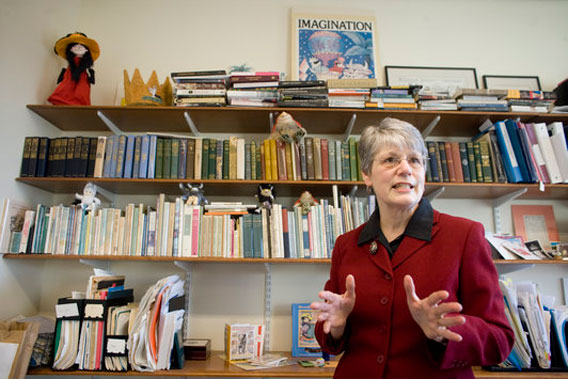Wild Things
Tisch Library director Jo-Ann Michalak brings her fascination with the art of Maurice Sendak to the office
By Helene Ragovin
The night Max wore his wolf suit and made mischief of one kind or another . . . it seems that he wandered into Jo-Ann Michalak's office.
Max, for those who haven't been studying children's literature lately, is the rebellious and ultimately chastened hero of Maurice Sendak's classic picture book, Where the Wild Things Are. A small plush toy of Max is just one of the many Sendak collectibles that live on the shelves of Michalak's office at Tisch Library, adding a touch of unexpected whimsy to the otherwise-academic environment.
Click on the play button to begin the slide show.

Collecting is another way of connecting to books, says Jo-Ann Michalak, director of Tisch Library. Photo: Melody Ko
As director of Tisch, Michalak spends her days absorbed in the administrative end of running the library. She says her literary collections-in addition to the Sendak memorabilia, she also collects pop-up books and 19th-century publishers' bindings-provide her with a different way of looking at books.
"That's my way, in addition to reading, of connecting to books," she says. "I like to look at them. I like to touch them. It's books as objects; books as fun things."
A shelf in Michalak's office is filled with dozens of Sendak books, both those he wrote and those he illustrated. Above them are the decorated publishers' bindings, a form of book cover that flourished between 1850 and 1920. And above that is a shelf of books by Tufts authors, faculty and alumni who have given readings at Tisch. Perched among the volumes are reproductions of Sendak's Wild Things; a large doll of his character Really Rosie; a crown similar to the one Max wears when he's named King of the Wild Things and posters and bookmarks gathered over several decades.
Michalak insists she is not a serious collector. That title, she says, rightly belongs to her husband, a retired Harvard librarian, who specializes in collecting political caricatures and work by the British illustrator George Cruikshank. She began to accumulate book-related things, she says, to have something to do when she accompanied her husband on book-hunting expeditions.
"Whenever we went someplace, he'd say, 'We have to go to bookstores,' " Michalak says. "So I had to entertain myself."
She was initially drawn to Sendak because her daughter's favorite childhood book was In the Night Kitchen. (That book, incidentally, scandalized many children's librarians when it first appeared in 1970 because it featured a naked and anatomically correct little boy named Mickey romping through a giant loaf of bread and bottle of milk.)
"I was responsible for a children's book study collection for a short time early in my career," Michalak said. "A professor in library school said that a really smart thing to do is to collect the books your children, or you, loved as a child."
Michalak became intrigued with pop-up books after happening upon some inexpensive ones at the Strand, the premier used-book store in New York City. "The pop-up books were not very popular, and they were remaindered," she recalled. "[My husband and I] said, 'These are so neat, and they don't cost very much. Let's buy a pile of them.' " Spoken like true collectors.
Helene Ragovin can be reached at helene.ragovin@tufts.edu.


